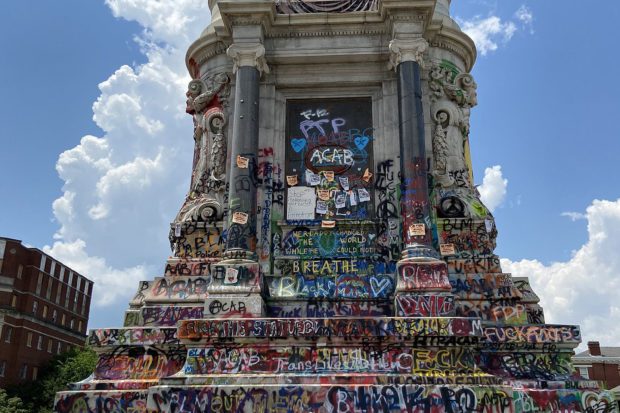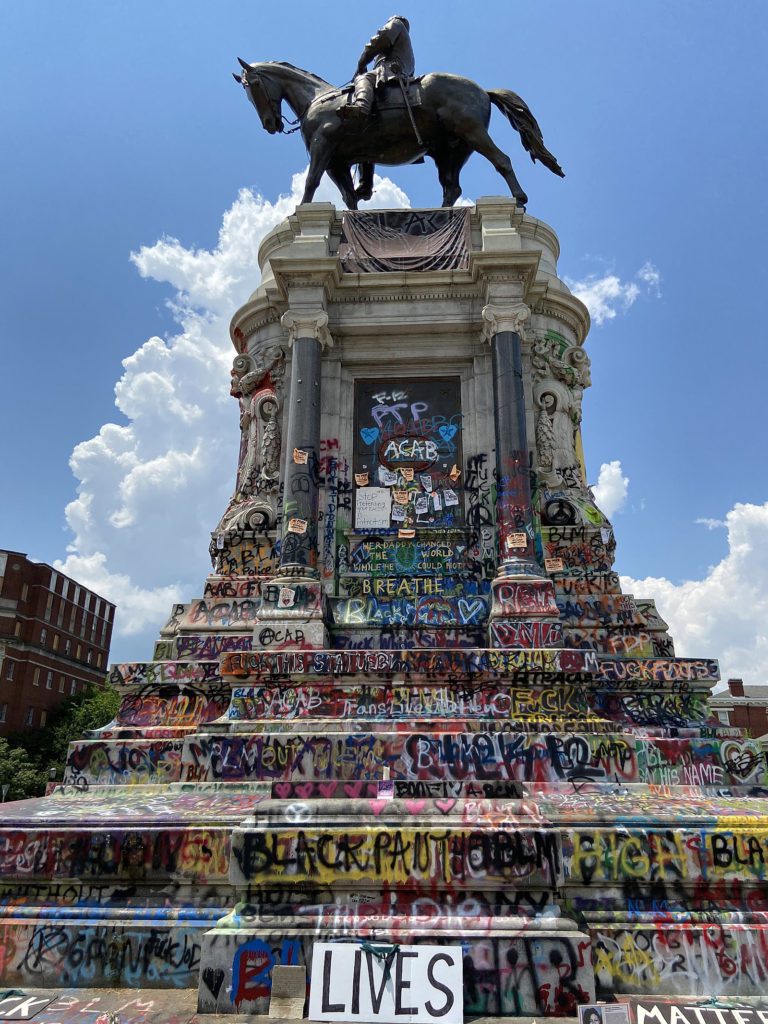

By Malik Simba
In an ironic twist, on Sept. 8, 2021, a Black construction company dismantled the enormous statue of Robert E. Lee on Monument Avenue in Richmond, Va., the capital of the Old Confederacy. For many traditional art lovers, this monument was sacrosanct, which meant it represented the idea of art for art’s sake.
However, this idea was the topic of debate during the Harlem Renaissance of the 1920s. In rejecting the idealism of sacral art, many Black artists claimed that all art should serve a social end that drives positive social change. This claim was redeemed and furthered by the Black Arts Movement of the 1960s.
Today’s activity to take down Confederate statues and monuments was prompted by the outrage sparked by two events: the murder of George Floyd and the earlier Dylann Roof mass murder of Black worshippers in prayer study at Emanuel African Methodist Episcopal in South Carolina.
Before Roof went on his murderous spree, he wrapped himself in a Confederate battle flag and took inspirational selfies of himself. This image led many cities to remove the public display of that flag.
Interestingly, can one imagine what would have happened to the monument at Stone Mountain, Ga., which has Mount Rushmore–sized images of southern rebel leaders Robert E. Lee, Jefferson Davis and Stonewall Jackson, if Roof had taken selfies standing next to that monument? Think sandblasting and the end to that reactionary piece of propaganda.
In 1953, President Eisenhower, before the Supreme Court handed down its decision to legally eliminate school segregation, had a few intimidating words to say to Chief Justice Earl B. Warren. In a private meeting, the President said the Court should be sympathetic to “white supremacist segregationists” because of their historical memory of losing the Civil War. Even with that loss, they were able to, with federal support, have a New South rise on the prostrated backs of the ex-slaves mired within the shadow of slavery and plantation.
My father, Theoplis T. Hogue, Sr., lived within this New South. He served on the Black police force that enforced law and order on the segregated Black side of Lexington, Ky. He was lucky; he attained a living wage job.
When our family moved to Denver, that city’s police force was segregated but provided no “black officers” to police the Black Five Points area. White police officers were eager to accept this White affirmative action.
As historian Ira Katznelson’s research proved, “Today’s social-economic order was…shaped by federally backed affirmative action for whites.” The New Deal for White men created a dual labor market with White men being the first hired but Blacks, minorities and women being the last hired and the first fired—clearly a “raw deal.”
Two examples demonstrate this point. In the 1957 federal report, Record of Progress, one company that employed 30,000 mostly White workers was commended for hiring two “Negro clericals.” In the same report, another company with a workforce of 20,000 workers was commended for hiring two “Negro supervisors.”
Angry White Men (AWM) did not appreciate these hires because they saw their White privilege slipping away. Because it was the Democratic Party that created this new type of affirmative action, AWM began to leave the party and move to the right, either joining the Republican Party or the American Independent Party of George Wallace, who offered them White supremacy, or segregation “now, tomorrow and forever.”
The popularity of White supremacy within a small segment of the American population is because, with ethereal blessings, these individuals are still alive. Some have passed on, but many who lived through this period, as did I, are alive and healthy. However, White supremacists who have passed away had “a good son” or “a good daughter” who, more than likely, embraced the misguided attitudes of their parents. Obviously, because of education, many children have rejected the misguided attitudes of their parents.
Still, when one sees the youthful White supremacists march in Charlottesville, Va., one can deduce that they have become their parents. One memory that stands out for me was leaning on a Confederate statue, at 12 years of age, and a White police officer telling me, using the N-word, that I would be arrested for loitering if I did not stop leaning on that statue.
Interestingly, it was just announced that Mayor Jim Gray of Lexington, Ky., moved by the tragic loss of life in Charlottesville, will shortly remove all such Confederate monuments in and around Lexington.
What happened in the recent Presidential election was stated clearly by David Duke, who attended the march with White supremacists in Charlottesville. What Duke said to President Trump, paraphrased here, is that we put you in the White House, and you best remember that.
What everyone saw on television was how historical memory drives the behavior of many today. The statue of the Confederate general, Robert E. Lee, became the bone of contention between two groups who remember history differently. One remembers the Civil War was about state’s rights and the other remembers a war to end slavery. However, states’ rights really meant the right of an individual within any southern state to hold another human being in the chains of slavery.
Last, perhaps the solution to the immediate conflict in Charlottesville is to maintain historical memory by moving all contentious artifacts of history into museums. History will become alive as the public views these monuments in their proper, protected space within museums. Hate, however, is a more difficult problem to overcome.
*****
Malik Simba is an emeritus professor of Africana studies and history at Fresno State.
